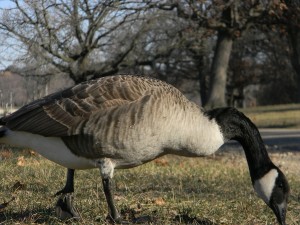Madison’s Parks Commission approved on May 11 a wide-ranging plan to reduce the number of Canada Geese throughout the city. Written by Parks Department Russ Hefty, solutions range from new shrubs to roundup killings.
His goal for Warner Park is six adult geese, a drastic reduction from current populations.
Here is Mr. Hefty’s details for Warner Park:
Warner Park—Reduce the giant Canada goose population to 3 nesting pairs (approximately 24 birds). This allows the public to enjoy seeing geese but will reduce their impact on the human and natural environment.
Implement the following strategies:
1. Continue egg oiling of nests in 2011 to reduce population growth. As of May 2, 2011 26 nests were located on the Warner Island with 102 eggs oiled/removed.
2. Expand unmowed vegetation buffers between bike path and playground near Forster Dr. in 2011 to discourage goose movement from water to land.
3. Monitor native plants in vegetative buffers (installed fall 2010) along lagoons. Remove protective fencing in late June 2011.
4. Seek DNR approval to place brush in lagoon along shoreline to discourage goose movement and protect aquatic emergents.
5. Plant aquatic emergents along selected shorelines and monitor for grazing impacts by geese.
6. Install an exclosure fence in a portion of the isolated wetland north of the bike path near Forster. Monitor vegetation to determine geese grazing impacts on native plants in this shallow
emergent wetland.
7. Establish American Lotus Watelily plants in targeted areas of lagoons to reduce open water areas :making it difficult for them to swim around (2011)
8. Conduct a controlled burn in early on the large island in the lagoon to reduce early nesting cover for 2011 nesting season. (Fall 2010 – Late Winter 2011) Burn completed on April 12, 2011. This management practice did not discourage geese nesting activity on the island.
9. Monitor the geese population in summer of 2011 to determine effectiveness of these measures. Recommend future management actions if summer molt population (in 2011) is not reduced by 25% from 2010 summer molt population count. Future actions may include humane capture during summer molt period to reduce the population of adult geese in the park.
You must be logged in to post a comment.